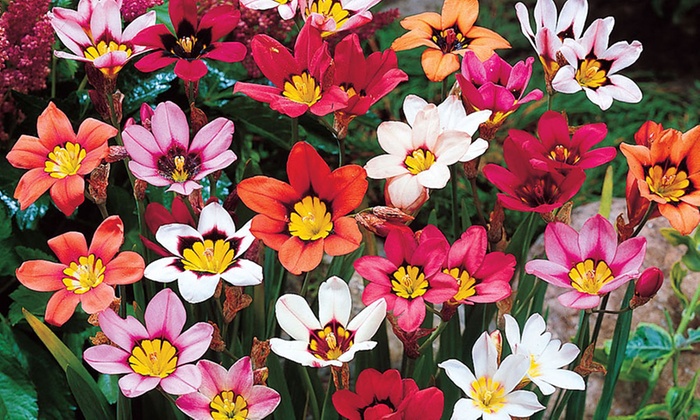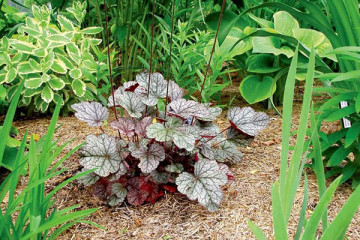Sparaxis planting and care in the open field
Content:
- Features of sparaxis
- Classification of sparaxis species
- Varieties that are very popular with gardeners
- Sparaxis - growing by seeds (disadvantages of the method)
- Bulb planting instructions
- Sparaxis - planting and care in the open field
- When and how it blooms
- Post-flowering care
- Possible problems in growing and care
Corms perennials - Sparaxis flowers cannot be called very common among horticultural crops. At the same time, they deserve attention, since they have a rich palette of shades, flowers that are bright and noticeable in any environment, and they also stand out for the flowering period - at the junction of spring and summer. When inexperienced growers see flowers as beautiful as sparaxis, they think that growing and caring outdoors will be incredibly difficult, but they are not. Further, the cultivation conditions will be discussed in more detail.
Features of sparaxis
A perennial corm plant - sparaxis (Latin Sparaxis) belongs to the Iris family (Latin Iridaceae). It is grown as a horticultural crop, home and greenhouse.
Most of the known sparaxis have been found in South Africa, particularly in the Cape region. A tricolor species (Latin Sparaxis tricolor) was brought from California.
Depending on the variety, the height of the ground part of the plant ranges from 15 cm to 60 cm. The leaves are similar to the foliage of a daffodil - smooth, bare, belt-like, rounded at the ends.
The flower is star-shaped and can be of almost any color. Corollas reach 5 cm in diameter. The tips of the bracts are split, which is reflected in the Latin name of the species.
Classification of sparaxis species
The most common species in garden culture are listed below.
Sparaxis tricolor (Latin Sparaxis tricolor)
Among domestic plant lovers, the flower is also known as sparaxis tricolor.
Bushes with xiphoid green leaves up to 40 cm tall with the same tall peduncles, in which the buds are collected in groups of 5-7 pieces. At the base of the petals there is a characteristic black ring, and the base is yellow.
Sparaxis graceful (lat.Sparaxis elegans)
A dwarf variety up to 15 cm high. Flowers are painted in a bright orange shade or white. The popular variety series "mix" combines several different shades at once.
The petals also have a black ring and a yellow center, almost completely covered by fused purple stamens.
Sparaxis Bilbifer (Latin Sparaxis bulbifera)
This species is one of the tall ones. The height of the bushes reaches 60 cm. Flower stems are erect, branched. At the ends, 1-2 buds bloom. Each flower is about 6 cm across.
Coloring occurs white, light cream, white-yellow.
Sparaxis grandiflora (Latin Sparaxis grandiflora)
This species is tall. The sheet plates have a belt-like shape. The flowers are large, elongated, they can be colored white, purple and deep yellow. The flowers have a very pleasant aroma, which is why this species is also called fragrant sparaxis.
Varieties that are very popular with gardeners
Sparaxis bulbs remain a rarity on sale, but the following popular varieties are available in large garden malls.
Elegans
The variety is represented by flowers of white and dark purple color. The corolla is colored black or purple. The stamens are black or white. Elegance has a noticeable pleasant aroma.
Superba
Medium-sized variety 25-30 cm high. The spike-shaped inflorescence is formed by 5-7 buds, blooming successively from bottom to top. The diameter of the corolla is about 5 cm.
The colors are orange, purple, white, yellow and red. The core of the flower is yellow or black.
Lord of fire
Very showy flowers with six petals, which have a bright yellow core and a blazing edge in all shades from pink to purple. Plant height ranges from 30-60 cm.
Jumbo Star Mix
Variety series (mixture) with tall stems and buds of all kinds of shades. This planting material is excellent for the formation of mixborders next to other bulbous plants that have different flowering periods.
Striped
The peculiarity of this variety is the unusual color spot at the base of the flower. The yellow sector is outlined by a black rim, which has a complex shape. In combination with petals of scarlet or orange color, the illusion of blazing lights is created against a background of bright greenery.
Sparaxis - growing by seeds (disadvantages of the method)
This plant is rarely obtained from seeds. The reason is that seedlings will be able to give their first flowers only in the 3rd year of life.
Crops are carried out in seedling boxes 10 cm high, filled with loose fertile soil. The germination period is up to 30 days. They are thinned out, leaving 2 cm between individual copies.
Transplanting into open ground is performed when the height of the ground part of the seedlings is 7-8 cm. In the fall they are dug up, and planted back only at the end of next May.
Bulb planting instructions
The bulbs are planted in well-lit, but protected from strong winds. In the shade, the flowers grow smaller. The soil should be well-drained, loam will do.
Planting depth - 5-7 cm, between flowers maintain a distance of 8-10 cm.
Sparaxis - planting and care in the open field
Agricultural rules for middle latitudes almost completely repeat the principles of caring for another popular horticultural crop - gladioli.
Flowers require regular watering, weeding, and loosening of the soil after watering. If the weather is hot and dry, then after sunset the bushes are sprayed with warm water from a spray bottle.
It is extremely dangerous to plant corms in flooded lowlands and in the shade of tall bushes and trees. When waterlogged, the underground part rots, and without the sun, the buds do not bloom.
- Watering
It is necessary to take care of plantings in dry times almost every day. As soon as the soil dries up from above, you need to immediately water it with settled water heated in the sun.
- Mulching
To avoid the need for frequent loosening between waterings, it is worth covering the soil with sawdust or peat. Weeds won't spawn either.
- Loosening
Since the depth of the bulbs does not exceed 8 cm, the soil should be loosened very carefully and superficially between waterings.
- Top dressing
It is imperative that, as soon as the first buds appear, a complex mineral fertilizer for flowering is introduced into the soil (20 g per 10 l of water). During the season, a total of 3 fertilizing is carried out, stopping them after the flowers wither.
When and how it blooms
Waiting for flowering is a pleasant time. It should be expected at the very beginning of summer or at the end, depending on the region.
- Types of flowers
All varieties have a corolla with 6 large petals. Inflorescences are racemose and spike-shaped with 2-7 buds.In the center of the corolla there is a large pistil with a stigma split into 6-8 lobes and 6 stamens with an overgrown or common base, ending in large black, red or yellow anthers.
- Flower shapes
The size of the corollas varies in a wide range of 2-7 cm. The newest varieties and hybrids, for example, Superba, have the largest flowers.
- Flowering period
If we are talking about the southern regions, where in winter the temperature does not drop below -5 ° C, then the flowers will bloom at the turn of spring and summer. Further north, in the Urals and Siberia, corms are planted at the end of May and flowering occurs at the end of August.
- Changes in care during flowering
Since the peduncles always have several uncommonly blooming buds, it is imperative to remove the wilted ones. So there are more chances that the rest will have enough strength to open up.
Post-flowering care
Wherever the air temperature drops below 0 ° C in winter, corms are dug up and stored in basements.
- Bulb digging process
Do not dig up sparaxis for the winter if grown as an annual. In other cases, at the end of flowering, yellowing of the ground part is expected in order to immediately dig out the corms.
- Drying and sorting tubers
You do not need to cut off the greens that did not have time to wither, you should wait for it to dry and break off. The corms are dried, cleaned of soil, sorted and stored in the basement at a temperature of +5 .. + 9 ° C. Shelf life: 2-3 years.
Possible problems in growing and care
With proper agricultural technology, the plant rarely grieves with its death. It is enough to inspect the planting every week and pay attention to the appearance of the bushes.
When water stagnates in the soil, corms suffer from rot. In advanced cases, the flowers die. If the color of the leaves becomes dull or yellow, it means that there is little iron in the soil, you need to fertilize with iron chelate. The most destructive factors are cold and lack of sun.
Most often, sparaxis can be seen on the alpine slides. This is one of the few bulbous species that does not require a powerful fertile soil layer and is not capricious for being close to other flowers. The main thing is to remember about its exceptional thermophilicity.

























